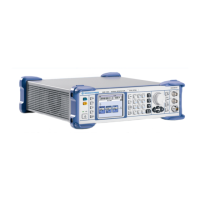Test Procedures R&S SMB
1407.0806.82 1.28 E-5
Setting Time
Test assembly Connect the spectrum analyzer (Table 1-1, item 18) to the RF
connector of the DUT.
Test method The spectrum analyzer is operated as a fast level meter in zero span.
A controller transfers the start and the stop level via the IEC/IEEE bus.
T
he analyzer is triggered by the positive edge on the EOI line of the
IEC/IEEE bus. At switch over from start to stop level, the settling
procedure is displayed on the screen of the analyzer.
Preparation of measurement Synchronize the reference frequencies of the DUT and the
analyzer.
Make IEC/IEEE bus and RF connections.
Connect spectrum analyzers trigger connector to EOI line (pin 5) of
IEC/IEEE bus.
Setting on DUT:
- Frequency: test frequency unmodulated,
- Level: start level
Settings on spectrum analyzer:
- REFERENCE LEVEL: target level + 3 dB
- AMPLITUDE LOG RANGE 10 dB
- RESOLUTION BANDWIDTH 200 kHz
- VIDEO BANDWIDTH 2 MHz
- SPAN 0 Hz
- SWEEP TIME: 10 ms
- TRIGGER EXTERN
- External triggering by positive edge at 1.4 V.
Measurement Send the stop level from the controller to the DUT.
The externally triggered analyzer displays the settling curve. The
setting time is defined as the time from which on the level
deviation from the final level is less than the specified deviation
in the data sheet.
Measure the following steps with ALC state AUTO, with ALC state
OFF (Sample & Hold) and in List mode.
Recommended test
frequencies and levels
Frequencies: 1 MHz, 30 MHz, 375 MHz, 1.1 GHz, 2.2 GHz, 3.2 GHz
and 6 GHz
Start level Stop level
-130 dBm +18 dBm
-35 dBm -5 dBm

